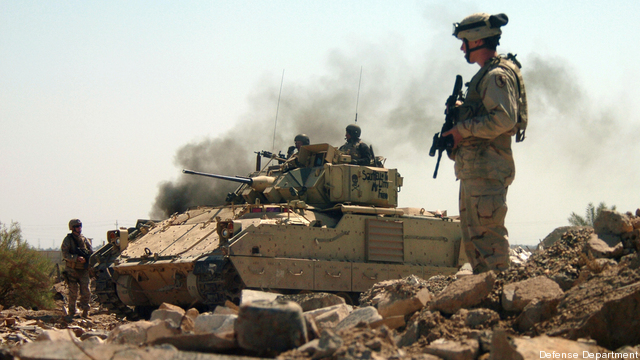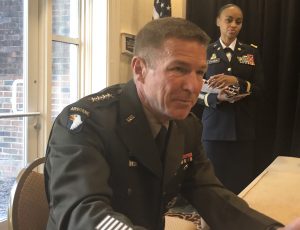
M2 Bradley crossing rubble in Babil, Iraq in 2005
WASHINGTON: The Army’s senior general offered a new argument for the service’s Next Generation Combat Vehicles: that the Army needs to upgrade its armored force for future city battles in an increasingly urbanized world.
“One thing, [when] we look into the armored force …is really the value of that in cities,” said. Gen. James McConville, the Army chief of staff. An aviator by training, McConville commanded the helicopter brigade of an armored unit, the 1st Cavalry Division, in Iraq, where he saw M1 tanks and M2 Bradleys in urban combat at first hand.

Gen. James McConville
“When I was in the First Cav Division, I got a chance to see how we used armored forces in Sadr City, how we supported Marines in Fallujah with armored forces, how we fought in Najaf and some of these other cities,” the Iraq veteran told a Washington Post webcast. “You can go back and even look at some of the other battles that we’ve had over the years.”
The idea that tanks are well-suited for city fights is counterintuitive but historically true. Yes, urban battlefields soak up huge numbers of foot soldiers to clear buildings, rubble, and sewers inch by blood-soaked inch. Yes, tanks without infantry support are easily trapped and ambushed in narrow city streets, as the Russians painfully discovered in the Chechen capital Grozny. Yes, the most famous armored advances occurred in open country, on the Great European Plain that stretches from Normandy to Moscow. And it’s the eastern portion of that plain where US Army armor has focused since World War II. Even today, the service is optimizing its future Optionally Manned Fighting Vehicle (OMFV) to move across Polish bridges.
But McConville and his fellow generals are eager to prove the Army’s relevance to the Indo-Pacific theater, where the US confronts its greater challenger, China. The Pacific, of course, is the world’s widest ocean, which is why the Army touts its new long-range land-based hypersonic missiles, able to traverse vast and watery distances in minutes — if it can find a place to base them. That project is deeply controversial, with Air Force Gen. Tim Ray saying bluntly that ground-based long-range missiles were “stupid” because they replicated what Air Force bombers could already do.
“We’re trying to provide options to combatant commanders,” McConville said of the missiles. “There’s sea-based, there’s air-based, and there’s also ground-based capabilities.” He declined to address Ray’s “stupid” comment, instead touting his collaboration with Air Force Chief of Staff Gen. C.Q. Brown. “At the [service] chief level, we’re not going down that road” of turf wars, he said. “We’re really trying to work together.”

Army M113 in Vietnam
But besides vast expanses of water, Asia also has some of the mostly densely populated landscapes in the world. And those Asian cities have seen fierce armored fighting in the past, including by US troops. M48 tanks proved particularly vital during the Tet Offensive of 1968, when Viet Cong troops infiltrated urban areas like Hue and had to be dislodged in ferocious block-to-block battles. Remember, tanks were invented in 1916 not as mechanized cavalry to conduct sweeping advances over open country, but as industrial-age siege engines able to shrug off machinegun fire, plow through barbed wire, and rumble across trenches. In an urban battle, just crossing the street under fire can be as deadly for unprotected foot troops as going over the top was on the Western Front. Armored vehicles can break such deadlocks and restore battlefield mobility as effectively in urban combat as in trench warfare.
In Iraq, of course, the Army relied on the massive M1 Abrams main battle tank and the lighter M2 Bradley Infantry Fighting Vehicle, both of which were upgraded with extra armor and “urban survivability kits.” But the Bradley had been upgraded so many times with electronics that its Reagan-era wiring wasn’t designed for that the chassis and power supply are almost maxed out. The Army’s still struggling, for instance, to install anti-missile Active Protection Systems on Bradley, whereas it already has them on the roomier Abrams.
If the Army wants to keep modernizing its armor, especially to take advantage of new automated technologies, it needs to replace the Bradley. That’s the goal of the Optionally Manned Fighting Vehicle now in early stages of development. OMFV is designed to operate both with and without a human crew aboard, and in conjunction with a new family of Robotic Combat Vehicles, forming a hybrid wolfpack of mutually supporting manned and unmanned systems. That way, in a potential ambush situation – urban or otherwise – future armored soldiers can send the robot in first.
“The reason we’re bringing on a Next Generation Combat Vehicle to replace the Bradley is because that’s going to change how we operate,” McConville said.






















